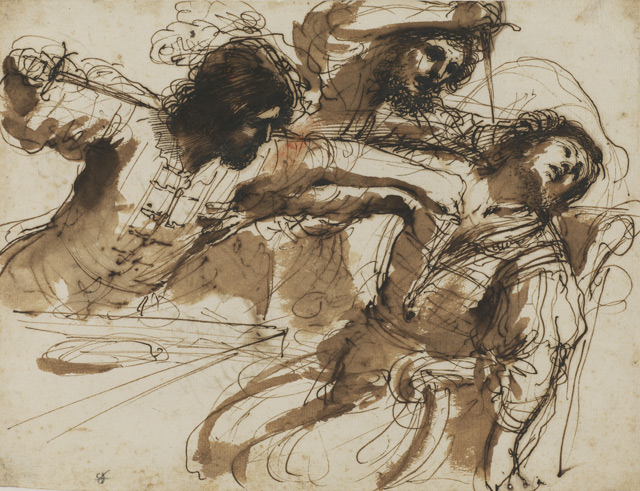The Old Masters
The works in the exhibition show the different use of drawing to European artists between 1500 and 1800. At this time art students entered the workshops of established artists to be trained. Afterwards they could become masters of their own workshops, if they were successful.
The artist Guercino was apprenticed to the painter Benedetto Gennari the Elder when he was 16 years old. He later established his own workshop and opened an academy for life drawing.

Guercino
The Assassination of Amnon at the Feast of Absalom
1628
Pen and brown ink, brush with brown wash
In Guercino's drawings I can feel the artist's pen scratching the paper. His favourite medium was a goose-feather pen dipped in ink that allowed him to quickly record his ideas on paper. Touches of wash, areas of diagonal lines increase the sense of drama. The drawing above is from a story in the Old Testament. Absolam brings in assassins to kill his half brother, Amnon, for having raped their sister, Tamar. Guercino's use of fleeting lines empahsises the drama and unexpectedness of the attack.
Teaching Drawings and Copies
Students in workshops and academies were set drawing exercises such as sketching sculptures. They sometimes made practice drawings as a warm up exercise to loosen the wrist. For many centuries copying was considered one of the best ways to learn, giving the students practical means of understanding the intention and expression of the master. The process of copying is an attempt to walk in the footsteps of the master and reconstruct all the major elements of their methodology in order to get the same qualities in the same way.

Peter Paul Rubens
God the Father surrounded by Angels, copied after Michelangelo's 'Creation of Adam'.
1601-2
Rubens learnt to draw by copying from the work of early German masters such as Holbein and Tobias Stimmer.
The Figure
Learning to draw the human figure was one of the fundamental parts of formal artistic training in Europe for centuries. Mastering its depiction was considered essential.

Baccio Bandinelli
Hercules seated on a grassy bank
1514
Red Chalk
First Thought Drawings
Artists doodled to explore ideas and for their own amusement. Some drawings are first thoughts that lead to a composition or are variations on an idea. Others are simply fantasies that never got beyond the pages of the sketchbook.

Guercino
Monster animal and peasant
1640
Guercino liked to show off his inventive imagination by drawing bizarre creatures for his own and friends amusement. This cockerel-like animal has been formed from a human foot and hand, the legs of a chicken and ears of a dog.

Domenichino
Portrait of a Young Girl
1634
Black chalk heightened with white on grey-buff paper
Domenichino liked to sketch portraits and caricatures for relaxation.
Presentation and Modello Drawings
A presentation drawing was shown to the person or group commissioning a work of art to illustrate what it would look like when completed. A 'modello' is a drawing or small-scale painted version of the intended final work.

Francesco Primaticcio
Ulysses and the Rings
1548
Red chalk and white heightening on pink prepared paper
This drawing fulfilled both a practical function, providing instructions to Primaticcio's assistants and an aesthetic role as an art object.
No comments:
Post a Comment